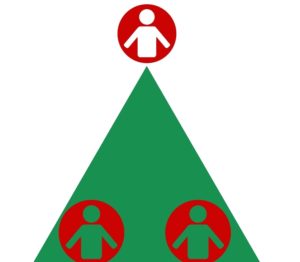 What is a “triangle” in a relationship?
What is a “triangle” in a relationship?
Today I am writing about the concept of triangulation from Family Systems Theory. We are all drawn into “triangles” which is our human way of decreasing anxiety and tension. In a triangle there’s a stronger bond that exists between two of the points and a third point is pushed to the outside. We know that tension feels uncomfortable and therefore it feels better to bring in a third person to help focus the attention or conflict elsewhere.
In a triangle, two people are on the inside and one is on the outside. For example, two siblings might team up on the third, or there maybe tension between two parents, thus one of the children is brought in as an insider to exclude the other parent. A third point of the triangle can also be inanimate. One parent may focus all his/her energy on work, bringing in work as the other insider, which pushes the partner to the outside. This will reduce the tension but will not be the solution to resolving the anxiety. Positions in the triangle change according to the tension. If the husband and wife are having a good day, they remain as the two insiders and then work, for example, is pushed to the outside. If they are having a stressful time with each other, one is pushed to the outside and work or a child is brought in as the insider.
In a family, the strongest bond should always be between the parents. In a well-functioning family, all members of the family deeply love one another but the point is that the parental bond needs to be the secure base of the family to avoid the “divide and conquer” dynamic.
What Are Some Examples of Triangulation?
- Two parents and a child
- Three friends
- Three siblings
- Two people and a third inanimate point such as one’s work, creative projects, exercise regime etc.
A family of two parents and two children can produce 4 different triangles and a family of two parents and three children can produce ten triangles!
Triangles occur within people of all ages and can be seen on the school playground, in the classroom, in the work environment and in the home. A certain degree of anxiety is normal within relationships but it needs to be worked through, not diverted to a third point.
When tension is very high, it feels more comfortable to be on the outside. Thus, the most uncomfortable insider will try to create conflict between the other insider and the outsider, thus enabling him/herself to move to the outside position. Once the conflict between these insiders has subsided the outsider will try to reclaim being the insider with the original partner once more.
How can we teach our children/teenagers about triangles?
In friendships, two friends may gossip about their third friend who in this case would be the outsider. If a friend asks another friend to deliver an emotionally loaded message to friend #3, then friend #3 is now the outsider.
It is important to teach children this dysfunctional dynamic in order that they are not drawn in.
Teenagers need to be aware of the triangle dynamic when they are dating. If a boyfriend has a girlfriend and they are romantically involved, one would think that they would have the strongest bond and be the insiders, but often, there is a third person, perhaps another girl who is “just friends” with the guy but they are emotionally close and gossip about the “girlfriend”. In this case the girlfriend is the outsider.
It’s important to recognize these situations and set boundaries. Guide your children to tell the friend or the boyfriend that they are not going to be the third person and if there’s problems between the original two that they need to talk directly and work it out between themselves.
How does one detach from a triangle?
- It is important to constantly work on oneself to develop individuation. If one can separate his/her feelings from others, set boundaries and make decisions for him/herself, one is more able to pull out of a triangle
- If one is able to see both perspectives of the other two individuals, and refuses to “take sides”, one is setting boundaries and detaching from the triangle
- If you recognize that yourself or a family member is getting involved as “messenger”, “peace maker” or “middle man/woman”, this person needs to disengage
- If there’s parent-child conflict, the resolution needs to occur between these two individuals, ultimately this will strengthen their relationship. This also role-models for children, how to handle conflict resolution directly and develop assertiveness skills
- If the parents are experiencing conflict, they need to work it out without having the children be involved. It is uncomfortable and unhealthy for children to be drawn into parental conflict
As I mentioned at the beginning of this article it is human nature to form triangles, therefore don’t be hard on yourself if this has been your pattern. Living our lives and parenting is a journey. The first step is having the awareness and then action can follow.
Have a wonderful week!
Warmly,
Want to Connect?
Subscribe now to receive free weekly parenting tips and inspiration.







